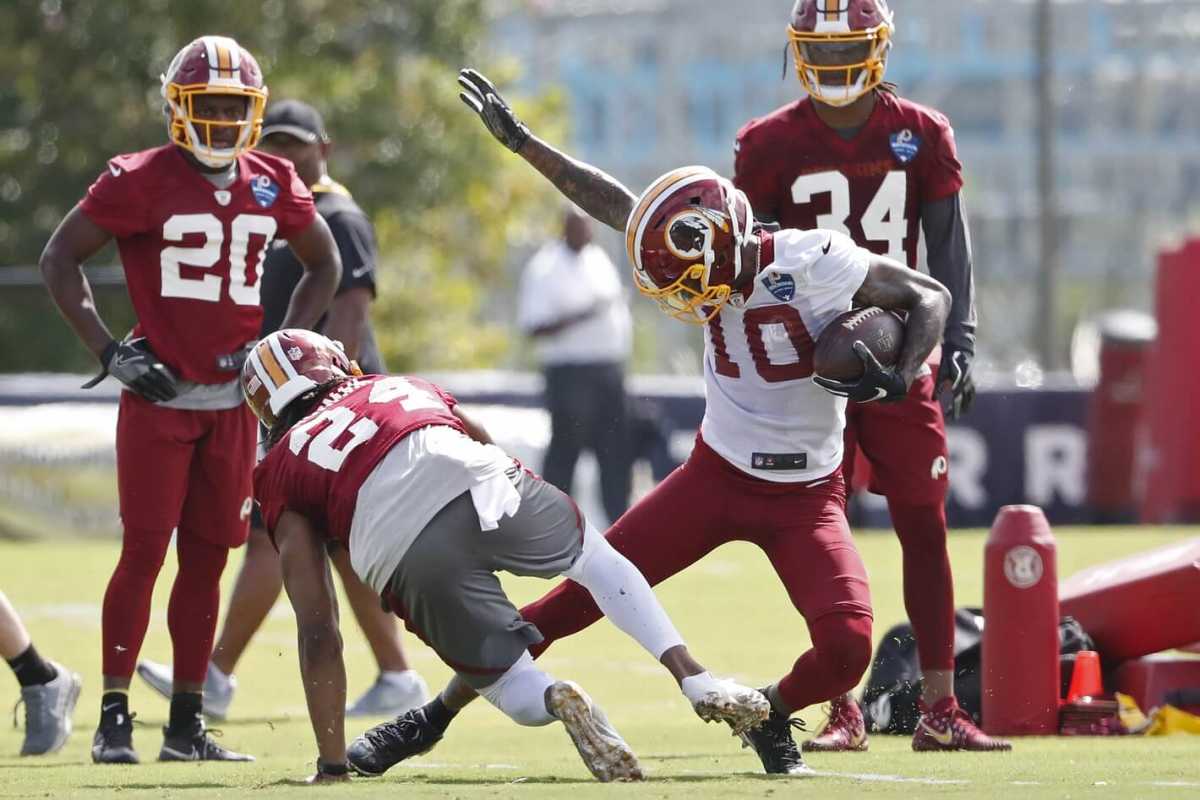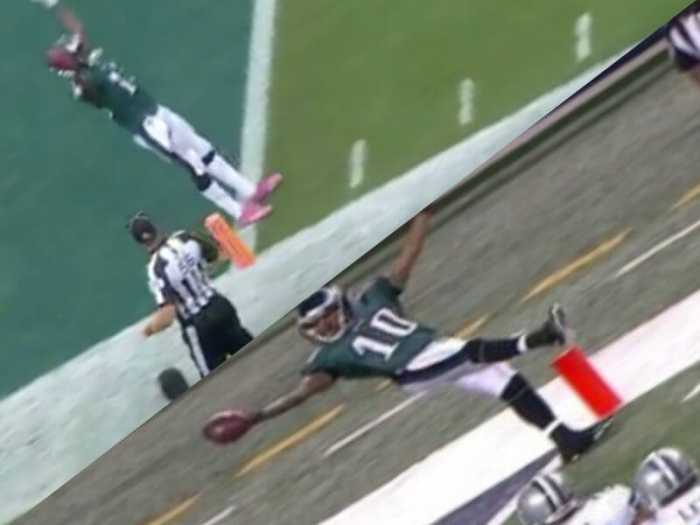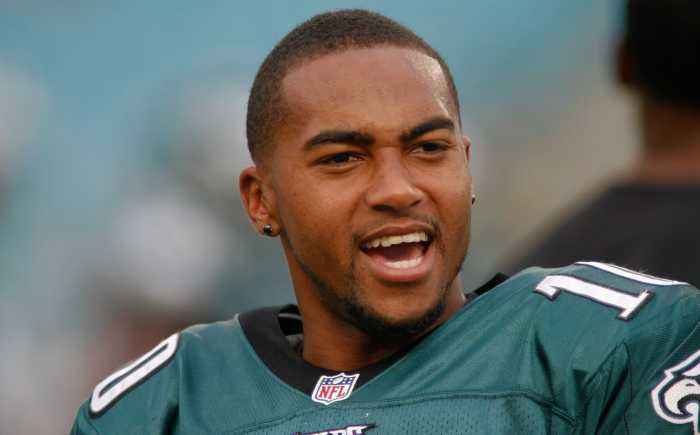Today on Know your Eagles Enemy, we’ll be diving into the Washington Redskins’ receiving corps. Similar to the Cowboy’s pass catchers, this group is hard to predict due to all the moving parts from last season. Projections are also muddled by the addition of new QB Alex Smith, new RB Derrius Guice, and a, hopefully, healthy offensive line. Will this group of inexperienced, unknown entities a dark horse in the passing game? Let’s find out.
Receivers
Heading into the 2018 season, the Redskins receiving corps is a who’s who of “who?”. Left with a receiving group starving for talent, Kirk Cousins was the sole reason the team was able to achieve anything through the air last season. Terrell Pryor was nothing as advertised, looking lost before missing the rest of his season due to injury. Jamison Crowder had a relatively down year, despite the huge leap expected of him. Josh Doctson may never be the player he was in college. Yet still, the team finished 12th in passing yards (234.4 yards/game), 8th in completion percentage (64.3%), 9th in passing touchdowns (27) and 11th in quarterback rating (93.9). In terms of more advanced statistics, Washington finished 9th in yards per completion (7.6), 14th in passing first downs, 12th in passing first down percentage (35.4%), 5th in passing plays of more than 20 yards (59) and 11th in passing plays of more than 40 (11). Overall, this is a pretty solid campaign for a team with a WR roster headlined by Crowder.
The truth is, this team let their two best receivers (Desean Jackson and Pierre Garcon) walk following the 2016 season without a solid backup plan. They then put all their eggs in converted-quarterback Pryor’s basket following a ridiculous season on the league’s worst team. 2018 may be round-two of trying to fit square shapes into round holes. At least with this off-season’s acquisition Paul Richardson, the Redskins have aimed for a square with rounded edges. Jay Gruden clearly misses the speedy Jackson and his ability to stretch the field. Even by watching minimal Redskins film, it is evident that this offence needs a can-opener – that is, someone to take the top off a defense. Being a premier deep ball receiver, Jackson averaged over 17 yards per reception and 55 yards a game over his three years in Washington.
Non-surreptitiously, Richardson was brought in to be the second coming of Jackson. To Alex Smith, he is the new Tyreek Hill. His 4.40 40-yard dash time, along with his 2017 numbers are reason for belief. When targeted on deep balls (20 yards +) last season, Richardson was the 4th best receiver in terms of quarterback passer rating (126.2), 12th in catch percentage (38.9%), 12th with 3 deep touchdowns and 10th in deep ball receptions as a percentage of total yards (39.1%). He totalled 7 receptions for 275 yards and 3 touchdowns on deep passes. His performance before the 2017 season is not indicative of consistent success. Akin to the Pryor situation, Richardson turned a good season into a Redskins contract. Antithetically, it wasn’t a one-year prove-it deal. Washington shelled out a 5-year $40M contract, with $16.5M guaranteed, to the former Seahawk.
| Richardson | Games | Receptions | Targets | Catch % | Yards | Yards/Rec | Touchdowns |
| 2017 | 16 | 44 | 80 | 55.0% | 703 | 16.0 (9th) | 6 |
| 2016 | 15 | 21 | 36 | 58.3% | 288 | 13.7 | 1 |
| 2014 | 15 | 29 | 44 | 65.9% | 271 | 9.3 | 1 |
*only caught one pass on one target in 2015
Unfortunately for Washington, the Seattle offence is very adept at propping up career number-two speedsters. Compare Richardson’s 2017 stats to those of his Seahawk WR2 peers over the years. Doug Baldwin is the only player on the list that has been considered a solid number one option in his career.
| WR2 | Receptions | Yards | Catch Percentage | Touchdowns | |
| 2016 | Tyler Lockett | 41 | 597 | 62.1% | 1 |
| 2015 | Tyler Lockett | 51 | 644 | 73.9% | 6 |
| 2014 | Jermaine Kearse | 38 | 537 | 55.1% | 1 |
| 2013 | Doug Baldwin | 50 | 778 | 69.4% | 5 |
Regardless of the speculation surrounding his contract and ability to compete as a number one, there are some areas where Richardson will come in and help immediately. First and foremost, I’m thinking that Washington wants to get better at improvisational football. Too often last season would a play break down and a marooned Kirk Cousins would be forced to take a sack or throw the ball away. Coming from an outstandingly ad-lib offence in Seattle, Richardson had plenty of practice with master improviser Russell Wilson. Plus, he is a talented contested-catch receiver. Last season he averaged 27.2 yards per reception on tight window catches. The video below shows a number of incredible catches by the former Seahawk – none more impressive than the first.
Add this to a surprising “clutch” gene and Richardson could be a big factor on important downs this season. In the fourth quarter last season, Richardson caught 16 passes for 330 yards, 15 first downs and 4 touchdowns. On third downs, he was targeted 22 times for 11 receptions, 9 going for first downs. Numbers like those reinforce the Redskins’ belief that Richardson just needs more opportunities. He only had 2 games with more than 5 receptions last season. At 6’0” 183 pounds, he is a willing, but not a dominant run blocker. However, this may be one of the underrated facets of his game.
Regrettably, Paul Richardson also has his limitations. His contested-catch ability masks his shortcomings separating from coverage. He will have to work on his route running if he is to fill Desean’s shoes. He doesn’t simply blow by defenders at will the way Hill can and Jackson used to. The ACL injury he faced in 2015 is the second of his career; he also suffered an ACL tear in college. Knee injuries are always cause for concern in terms of longevity and re-aggravation, especially for players so dependent on mobility. Most significantly, Richardson is susceptible to bad drops. Unofficially he had 6 drops in 2017. Contrary to his ability to catch in traffic, he is prone to dropped passes when he is wide open. I see this problem lessening as he settles into his role with the team. If nothing else, it can be assumed that Richardson will bring a true deep threat to a team that was noticeably without one in 2017.
The key piece to the puzzle will be third-year receiver Josh Doctson. Personally, I attribute Doctson’s lack of production to a misuse of his abilities. Previously I mentioned Jay Gruden’s obsession with replacing Desean Jackson. Overlooked in his escapade was the jarring loss of Pierre Garcon. Washington had hoped that Pryor would fill the shoes of the talented possession receiver, and began grooming Doctson for the downfield-threat role. To Washington brass’ credit, he was a talented deep ball target in college, but he was also able to outrun, out-muscle and out-jump the majority of his opponents. The TCU product’s biggest asset is his length. He’s only 6’2”, but has the wingspan of a pterodactyl. Accordingly, the Redskins have attempted in every which way to throw him jump balls way downfield. 25% (19) of his 78 targets last season were beyond 20 yards. He caught 5 of those passes (for a catch rate of 26.3%). He also unofficially broke up 4 interceptions last year. These aren’t jump balls people, these are prayers. Doctson’s career so far has been a let down.
| Doctson | Games | Receptions | Targets | Catch % | Yards | Touchdowns |
| 2017 | 16 | 35 | 78 | 44.9% | 502 | 6 |
| 2016 | 2 | 2 | 6 | 33.3% | 66 | 0 |
| 2015 (TCU) | 10 | 78 | – | – | 1,326 | 14 |
Despite the young man’s potential as a big play receiver, I think the Redskins need to do a better job finding him high-percentage completions. Think Julio Jones: while many know Jones for his downfield prowess, he has made a lot of his money catching slants and posts. He also averages almost 10 targets a game over his career. He is a big, long target that knows how to use his massive frame to out-muscle and outmaneuver opponents. Think of any top receiver for that matter: very few of them can survive on 50/50 jump balls and deep shots alone.
**GET FREE SHIPPING ON OFFICIAL EAGLES GEAR AHEAD OF THE NEW SEASON**
There are some indications that the Redskins’ receiver could re-enact a Nelson Agholor-esque third year renaissance. The first hint of Doctson’s potential is his ability when catching in traffic. Cousins averaged a passer rating of 69.3 when targeting his young receiver in tight windows. That makes him a top 15 target in traffic. Furthermore, 26 of his 37 career receptions have gone for first downs. While this is perhaps more indicative of his role than his ability, you have to like the fact that he can get open downfield consistently. He is also an imposing target in the red zone. Four of his six touchdowns came within an opponent’s 20-yard line. His length is something that cannot be coached, and regardless of his overall production, he should continue to be a formidable foe in that area of the field.
Agholor’s big break came with a position change from wide-out to slot. While I don’t see Doctson taking snaps away from Jamison Crowder on the inside, he could see a slight change in role with the arrival of Richardson. Differences between the two receivers’ first seasons cloud Doctson’s projection. In his first two seasons, despite being slammed for a drop problem, Agholor managed a catch rate of 52.3% and 52.4%. Last season he finished the season with 65.3%. Doctson’s career catch rate is 44.0%. He is also has only five receptions on 20 targets on third and fourth down. If the TCU alum is to connect well with new QB Alex Smith, he will probably have to assume a role similar to what Jeremy Maclin played in Kansas City. In his lone thousand-yard season with the Chiefs, Maclin had a catch rate of 70.2%. To achieve a growth of that magnitude, Doctson will need to work on his route running.
https://gfycat.com/healthykeyhapuku
The clip above is actually one of the better examples of the wide-out’s route running. An unconvincing corner resulting in a relatively simple jump ball in the end zone. Coaches and analysts have spoken highly of Doctson’s improvements since his rookie season, but I’m not convinced. He will need to do more if he is to compete as a number one option in a pass-heavy offence. Coming out of college, he was touted for his alpha-dog mentality. So far as an NFL player he has shied away from contact, and demonstrated a lack of effort when he is not the primary option. A breakout season will take a lot of pieces falling in the right places, but it’s not unimaginable.
The third starting receiver for Washington, and perhaps their most talented, is small slot receiver Jamison Crowder. The 5’9″ 177 pound 4th-year player was the team’s leading receiver in 2017. He is a talented route runner, and a constant threat after the catch. This season he will be playing for a new contract with a team that has been notoriously bad with contract negotiations in the recent past. This could fuel a career year, or factor as a distraction.
| Crowder | Games | Receptions | Targets | Catch % | Yards | Touchdowns | YAC |
| 2017 | 15 | 66 | 103 | 64.1% | 789 | 3 | 363 |
| 2016 | 16 | 67 | 99 | 67.7% | 847 | 7 | 386 |
| 2015 | 16 | 59 | 78 | 75.6% | 604 | 2 | 342 |
An accomplished slot specialist is something Alex Smith hasn’t really had in his career. In 2016, Smith targeted his slot receiver 204 times, finishing 20th out of qualified quarterbacks. In the same season, Kirk Cousins ranked 2nd with 278 slot targets. Smith was also 16.2% more efficient when targeting outside receivers. The Smith-to-Crowder connection might take some time, but is essential for the offence. For his career, Crowder is 60/91 on third down, for a catch rate of 65.9%. However, as mentioned in a previous article, Smith has a tendency of throwing short of the sticks on third-and-ten. The receiver has been mildly efficient in these situations. His 23 receptions on 30 targets on 3rd and 10 is pretty incredible, however these receptions only resulted in 10 first downs. He will greatly benefit from the healthy return of TE Jordan Reed, who will help alleviate pressure over the middle of the field.
It’s difficult to imagine a scenario in which Jordan Reed plays all 16 games in 2018. Sports Injury Predictor estimates a 68.3% chance he misses at least a game, and projects him missing 5 games. He has never played a full season in the NFL, and he has been inactive or on the injury report for 50% of his professional games. Below is a list of his NFL injuries. He has also suffered five concussions over his professional and collegiate career.
| 2017 | Pedal: Toe Fracture, Thigh: Hamstring Tear Grade 3*, Chest: Pectoral Bruise, Pedal: Toe Fracture |
| 2016 | Shoulder: A/C Joint Separation, Head: Cranial Concussion Grade 1 |
| 2015 | Knee: MCL Sprain Grade 2, Head: Cranial Concussion Grade 1, Leg: Quad Strain, Thigh: Hamstring Sprain/Pull Unspecified Grade 1, Knee: Strain Grade 1 |
| 2014 | Thigh: Hamstring Sprain/Pull Unspecified Grade 1, Thigh: Hamstring Strain Grade 2, Hand: Thumb Sprain |
| 2013 | Head: Cranial Concussion Grade 3*, Leg: Thigh Bruise |
Required Surgery Missed Game(s) *Season Ending
He had off-season surgery to remove bones in the big toes on both of his feet. A seemingly serious step may have a profound effect on the lingering foot and hamstring injuries, but concussions are still a major concern. If he is able to remain on the field, Reed is one of the best weapons in the NFL. He has never posted a catch rate below 74%, and has averaged at least 50 yards a game for half of his career. For the sake of argument, let’s assume the intelligent people at Sports Injury Predictor are correct. If Reed is to play 11 games in 2018, below are his top and bottom line projections based on his career averages.
| Receptions | Targets | Catch % | Yards | Yards/Game | Touchdowns | |
| Best Case | 69 | 90 | 76.7% | 748 | 68 | 9 |
| Worst Case | 47 | 64 | 73.4% | 387 | 35.2 | 4 |
If the Redskins are left without Reed’s services, Vernon Davis is a more-than-serviceable backup. Since 2014, he is the third ranking tight end in yards after catch and ranks first in missed tackles forced per reception. He has lost some physicality and athleticism, but is a savvy route runner and will be a contributor regardless of playing time.
| Snaps | Receptions | Targets | Catch % | Yards | Touchdowns | Yds/Snap | |
| 2017 | 799 (79.0%) | 43 | 69 | 62.3% | 648 | 3 | 0.811 |
| 2016 | 672 (63.4%) | 44 | 59 | 74.6% | 583 | 2 | 0.868 |
I include yards per offensive snap as a good measure to pin point the drop off between Reed and Davis. Reed’s yards per offensive snap for his last three seasons were: 0.902, 1.212 and 1.356, respectively. The younger tight end also has the benefits of increased targets when on the field. Since 2015, Reed averages 0.158 targets per offensive snap to Davis’ 0.087. Davis plays a clear second fiddle to a healthy, or even slightly-banged-up Jordan Reed, but has carved out a role for himself regardless of Reed’s availability. This role may increase with a familiar face in Alex Smith entering the picture. The duo fared quite well when they were together in San Francisco. Familiarity will make Davis an early favorite for underneath targets.
For the sake of length, I will briefly run through the rest of the group with a quick list of pros and cons.
2017 sixth-round pick Robert Davis is 6’3″ 219 pounds and ran a 4.44 40-yard dash. He is a physical receiver who uses his body well and has NFL traits. He will need to work on his intangibles. He is a raw prospect, with below-average route running and long-speed and spent the year on the practice squad because of it. However, he is quick for his size, and is a great contested catcher. So far, he has been receiving positive reviews out of OTA’s and mini camp.
Maurice Harris is 6’3″ 200 pounds and ran a 4.62 40-yard dash. He was promoted to the active roster in week 7 of the 2016 season. Unfortunately, he was injured in last summer’s mini camp and lost a lot of ground by missing the preseason. He was activated in week 9 last season for a game against the Vikings. It was during that game that he made one of the catches of the year; video below. He then suffered a concussion against Dallas in week 12. In his small sample size, Harris has put himself in contention for significant snaps in 2018. In 2016, he finished 4th among draft eligible receivers in passer rating when targeted (141.5) and had a 60.00% catch rate on third down – second best on the roster. He has a high football IQ, is a good route runner and a solid run blocker. Where he loses a step is in his athleticism. Harris has a clear ceiling, but has the tools to overcome a lack of explosion.
Brian Quick brings a veteran presence to the group. He did enough in 2017 to earn himself a minimal contract to stay in the nation’s capital. He is physical, but not a spectacular receiver and has only finished in the top 100 receivers in the league once, when he ranked 87th on Pro Football Focus’ list. The knock against him coming out of college was his inexperience. He is now entering his 7th NFL season. Bottom line, he is an accomplished special teamer, and will likely get snaps in that phase if he makes the final 53.
Trey Quinn was this draft’s Mr. Irrelevant, but may be anything but. He was an exceptional high school receiver, breaking the Louisiana state record for receptions. At 6’0″ 203 pounds, he is built like a running back and ran a 4.55 second 40-yard dash. In 2017 he led the nation in receptions with 144 and added 1,236 yards and 13 touchdowns. Quinn played snaps on the outside and in the slot at SMU, but will likely be a slot receiver in the pros. He has good footwork, is a precise route runner and is not afraid to catch passes over the middle of the field. He has a knack for finding the soft spot in the zone, and will work back to his quarterback. Nevertheless, he is not overly athletic and faced soft competition in college. He will have to rely on his intelligence and win with leverage by setting up defenders with counter moves at the next level – something he should prove capable of. I don’t know if he plays much this season, but keep an eye on the young man going forward.
Simmie Cobbs Jr. is a big, tall receiver with a huge catch radius. The 6’3″ 220-pound Indiana product will probably be a practice squad player this year, but fans may be waiting with baited tongue for his preseason debut should he make the team. He is a former basketball player and is capable of some spectacular catches. He is also capable of some spectacular drops, and had a 11.4% drop rate in college. Talented at high-pointing a football, Cobbs struggles with anything below his waist.
Best Case: The group will hinge on the development of Josh Doctson. If he is able to alleviate some pressure on Jamison Crowder and newcomer Paul Richardson, the passing game could thrive. We’re talking a thousand-yard season for Crowder, and another 6-touchdown season for Richardson. Trey Quinn can sit and learn from Crowder early on, getting in on some action later in the year. I don’t believe there are two thousand-yard receivers on the team, but an 800-yard season from Richardson and/or Doctson is plausible. 4,000 team receiving yards should be the team’s benchmark. It might be too much to hope for a full healthy season from Jordan Reed, but if he could play 13-14 games, that would be huge for this offence. Two tight end sets with he and Vernon Davis has been difficult for defenses to handle in the past.
Worst Case: Jordan Reed is on the injury report early and often. Jamison Crowder simply can’t carry this team, as proved last season. In this scenario, Doctson never puts it together — which is more likely than most ‘Skins fans will care to admit. Richardson is another one-year wonder, but this time the team can’t offload him in the off season. The team has a few young possible contributors, but none of them are starters. Poor Alex Smith does his best, but Jay Gruden is no Andy Reid and Richardson is no Tyreek Hill.
Mandatory Credit: Geoff Burke-USA TODAY Sports































